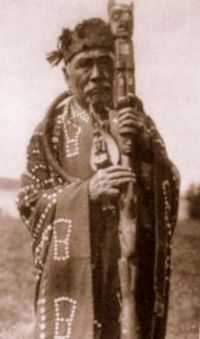Talking stick

The talking stick, also called a speaker's staff,[1] is an instrument of aboriginal democracy used by many tribes, especially those of indigenous peoples of the Northwest Coast. The talking stick may be passed around a group or used only by leaders as a symbol of their authority and right to speak in public.[2]
In a tribal council circle, a talking stick is passed around from member to member allowing only the person holding the stick to speak. This enables all those present at a council meeting to be heard, especially those who may be shy; consensus can force the stick to move along to assure that the "long winded" don't dominate the discussion; and the person holding the stick may allow others to interject. Talking sticks have high ceremonial and spiritual value, and have proved to be exceedingly useful during current implementations.
Akan chiefs in Western Africa have a tradition of speaker's staffs capped with gold-leafed finials. These emerged in the 19th century as a symbol of the holder's power.[2]
Northwest Coast art

In the Northwest Coast, talking sticks are carved wooden staffs, which can either bear a single crest at the top or be fully carved with heraldic clan crests of the chief or hereditary political spokesman.[1] The staffs can include shell inlay.[2] The staffs resemble small totem poles and are still used ceremonially today.[3] At gatherings, especially potlatches, a chief or his designated speaker holds the talking stick and publicly announces message.[3][4] The speaker thumps the stick on the ground for emphasis.[3] A feather has been used as a stand-in for the talking stick.[5]
Talking sticks are a contemporary Northwest Coast art form with great symbolic importance. Tsimshian woodcarver David A. Boxley was commissioned to sculpt a crown of a talking stick for the 1990 Goodwill Games, that incorporated symbolism of the United States and Russia. This staff was carried from Spokane, Washington to Oregon and on to Seattle, Washington by participating athletes.[6] Talking sticks are also incorporated into totem poles. In 1988 Kwakwaka'wakw Richard Hunt carved the world's largest totem pole featuring a Cedar Man wielding a 4.3 meter (14 foot) tall talking stick.[7][8] Representations of chiefs are carved in totem poles carrying talking sticks as well as coppers.[9]
Use in talking circles
Interest in native tribal culture has seen a revival of talking stick and its application spread widely. The use of the talking stick, organized as a talking circle, is a means of decision and discussion-making for groups as diverse as the Scouts and the Rainbow Gathering movement where the talking stick's effectiveness has been proved in a current context. Groups of school children are said to also commonly use talking sticks in circles, as well as adult and corporate groups across many cultures.
Rainbow Gatherings use talking circles to resolve disputes, where all are given the benefit of the talking stick (or feather, or other chosen object). An especially useful feature of the talking stick strategy for dispute resolution is that it can be used to forestall dangerous decisions in the way a filibuster can be used in some modern law-making bodies; conversation can be continued until one party gives up or, in some cases, falls asleep. This was used at the 2010 Rainbow Gathering, when there was an attempt by a renegade "pro-alcohol" faction to burn a large cross.
Notes
- ↑ 1.0 1.1 Wade 31
- ↑ 2.0 2.1 2.2 Werness 295
- ↑ 3.0 3.1 3.2 Stewart and Tait 41
- ↑ Shearer 103
- ↑ Shearer 46
- ↑ "Artist's Profile." David Boxley. (retrieved 27 Oct 2011)
- ↑ Stewart and Tait 115
- ↑ "Cedar Man Holding Talking Stick – Richard Hunt 1988." Cowichan Valley Travel, Tourism and Photography Information. retrieved 27 Oct 2011
- ↑ Stewart and Tait 141
References
- Shearer, Cindy. Understanding Northwest Coast Art: A Guide to Crests, Beings, and Symbols. Vancouver: Douglas & McIntyre, 2000. ISBN 0-295-97973-9.
- Stewart, Hillary and Norman Tait. Looking at Totem Poles. Vancouver: Douglas & McIntyre, 1993. ISBN 978-1-55054-074-1.
- Wade, Edwin L. 's%20staff&pg=PA4#v=onepage&q=Tlingit%20speaker's%20staff&f=false The Arts of the North American Indian: Native Traditions in Evolution. Hudson Hills, 1995. ISBN 978-0933920569.
- Werness, Hope B. Continuum Encyclopedia of Native Art. Continuum International Publishing Group, 2003. ISBN 978-0826414656.
Further reading
- Cultural anthropology: the human challenge, William A. Haviland, Harald E. L. Prins, and Dana Walrath, 2007, source
- Researching the culture in agri-culture, Michael M. Cernea, and Amir H. Kassam, 2005, source